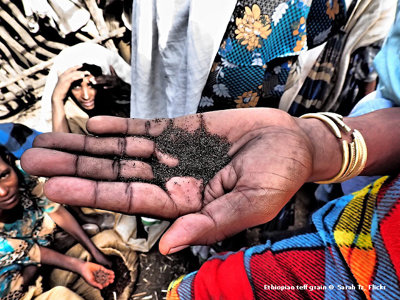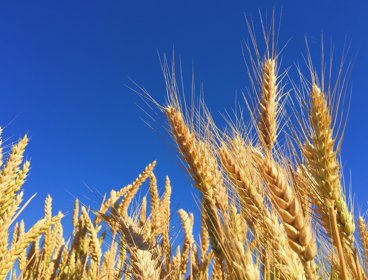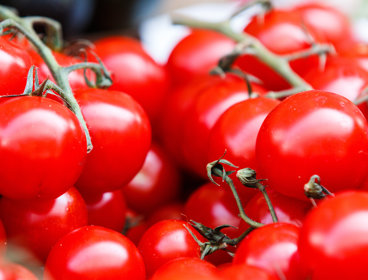September 2016
How important are grains to global food security?
Most of us start our day with breakfast cereal – perhaps cornflakes, Weetabix, or shredded wheat. Whilst cereals are obviously grain-based, grains are also vital for the milk or yogurt that accompanies them. It takes at least half a kilogram of grain fed to an animal to produce a litre of milk (Head et al, 2012). Infact, grains make up 45% of the world’s diet (National Geographic, 2011). Often the global dominance and significance of grains, and more broadly plants, is overlooked due to their embeddedness in everyday lives. But plants are fundamental to human survival – playing a key role in many important environmental political issues of the century, including biofuels, carbon economies and food security (Head et al, 2014). Whilst there are more than 5,000 known edible plants in the world, two-thirds of plant-derived food is provided by only three grains: maize, wheat, and rice (Cheng et al, 2014). This raises concern that dependency on only a few crops may limit our capability to deal with the challenges for global food security posed by the adverse effects of climate change if weather patterns become more unpredictable, and potentially, hostile. This is particularly pertinent to Sustainable Development Goal number two, which aims to ‘end world hunger, achieve food security and improved nutrition and promote sustainable agriculture’.
More than 90% of the world's teff is grown in Ethiopia
Running alongside these global issues, has been the rise of health-conscious eating in developed countries. Food movements such as ‘clean eating’ value certain vegetables and plants as ‘superfoods’ for their high protein and potential anti-oxidant qualities. As more consumers become more knowledgeable about their food, diets are changing as a result. In 2016, 12% of British people say they, or a member of their household avoids gluten – either as a result of coeliac disease or gluten sensitivity – and the sale of gluten-free food reached £247 million in 2015 (The Telegraph, 2016). It is in this landscape that grains such as quinoa have entered ‘the health food vernacular’ (Geographical Magazine, 2016) and latterly ‘teff’- a staple food for over 500 million people in the Horn of Africa and naturally gluten-free – has been pipped as the ‘next big thing’ (New York Times, 2016). More than 90% of world’s teff is grown in Ethiopia.
This resource encourages pupils to think about Teff farming in Ethiopia as a case study, the global food supply chain, as well as considering various conceptualisations, and inequalities therein, of health and disease in the Global South and Global North. Overall, it encourages pupils to engage with commodities, and objects that are potentially less visible – grains and plants – but by no means less political and geographical.
What are superfoods?
The term ‘superfoods’ refers to certain food stuff that is not only nutritionally good for you, but may also have health-improving, or anti-oxidant, qualities (NHS, 2016). For example, the grain quinoa is celebrated for such qualities – and imports (from South America) into the US increased more than tenfold between 2004-2013. Indeed, quinoa is now grown in the UK too; around 700 tonnes was produced here 2016 (British Quinoa, 2016). Teff has been grown in Ethiopia for millennia, but there are suggestions that it may become the new ‘super gain’ or ‘superfood’ of choice in Europe and North America – overtaking quinoa and spelt (BBC, 2015). Teff is naturally gluten-free and can provide substitute for wheat flour in anything from bread to pasta.
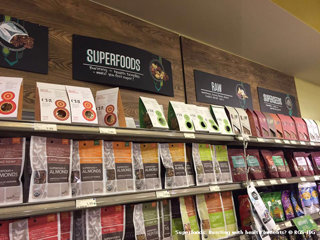
The case of quinoa - exploring a complex grain and its politics:
-
Can vegans stomach the unpalatable truth about quinoa? - The Guardian
-
Quinoa: good, evil or just really complicated? - The Guardian
What is teff?
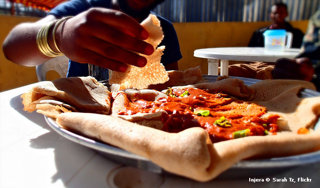
Teff is one of the earliest cultivated plants in civilisation and is a seed of a grass native to Ethiopia where it is the most important domestic staple food value chain. This makes it an extremely significant crop, not only in terms of generating income for farmers, but for national food security. Ethiopia has a population of 77 million people, and half of these currently live below the poverty line; it also has the highest level of child malnutrition in the world (Oxfam, 2016).
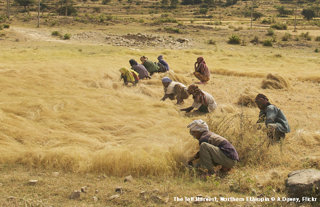
Most notably, teff is used to make injera – a traditional flatbread and national dish to Ethiopia. The seeds are ground into flour and produce a spongy pancake that is served with a variety of stews and salads.
To find out more about food geographies in Ethiopia, see this video by sustainable food documentary makers 'The Perennial Plate' (2014).
Where is teff grown?
Teff is Ethiopia's most important crop by planted area and is grown on an estimated 6.3 million farms
Teff is small in size – one handleful of small grain is enough to sow a typical field – this makes it ideally suited to semi-nomadic life. It is grown at relatively high elevations and in regions with adequate rainfall; it can be produced from sea level to as high as 3,000 meters of altitude. Teff is tough and can withstand adverse weather conditions, making it a lower risk crop than other cereals and grains. It is Ethiopia’s most important crop by planted area and grown by an estimated 6.3 million farms (The Guardian, 2014). In total, fields of the crop cover more than 20% of all land under cultivation in the country – this generates £380 million in income per year for Ethiopian farmers. The Ethiopian Government forbids farmers from exporting so that the grain stays affordable for its nation due to concerns it could be sold back to the market at inflated prices. So then, in some instances, teff consumed in other parts of the world is often grown elsewhere – for example, in Australia, India, and North America.
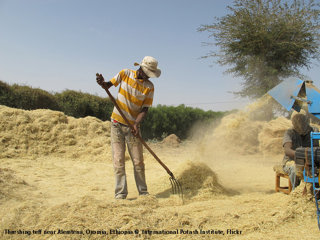
Where is teff consumed?
Recently teff harvests have failed to keep pace with Ethiopia’s increasing population, driving prices beyond many Ethiopian’s pockets, especially outside of the capital city of Addis Ababa (BBC, 2015). Ethiopia's growing middle class is also pushing up demand for teff, and rising domestic prices over the past decade have put the grain out of reach of the poorest.
Today, most small farmers sell the bulk of what they grow to consumers in the city. Teff is therefore a food for more socially and economically powerful in Ethiopia, and consumed relatively more frequently by rich than poor (Meiten et al, 2015). Often, this occurs along rural and urban divides; estimates suggest that people living in urban areas eat up to 61kg of teff a year, whilst in rural areas, the figure is 20kg. It is not only the distribution, but quality of teff that is disparate in Ethiopia. Those with higher income eat the most expensive variety of white teff, whilst less-wealthy consumers eat mixed teff, combined with cheaper cereals such as sorghum and maize – teff is twice as expensive (Meiten et al, 2015).
What may happen if teff becomes popular in the Global North?
There is a social and economic concern that if teff becomes popular in the global north then demand may soar, and with it there is the risk of unsustainable land and labour practices (The Guardian, 2014). This political economic narrative has troubled consumers of quinoa too. But are such concerns born out in reality? For example, research has shown that when, due to popularity, the price of quinoa increased, it had a positive knock-on effect for entire communities, with everyone benefiting from the new wealth of quinoa producers (Geographical Magazine, 2016). If production is ethical, and profits stay with the communities that grow such crops, this is a positive development (The Guardian, 2015). Unlike sugar or palm oil, which has to be grown on large plantations that could be environmentally destructive, as discussed, teff is usually grown by extremely small-scale operators.
So could the benefits of teff's popularity be widely shared? With the Ethiopian government embargo on teff exports in place, local farmers may not feel the benefit of increased production – teff consumed in the UK and beyond is likely to be produced elsewhere. But, if popularity increases, could the Ethiopian government consider allowing exports that could benefit other people?
Keywords
Grains
A single fruit or seed of a cereal
Superfoods
A nutrient-rich food considered to be especially beneficial for health and well-being
Lesson ideas
Pupils should research where teff is produced and consumed, outside of Ethiopia, and annotate a map of the world accordingly. Research the social and economic climate of these places and in groups discuss the similarities and differences with the case study of Ethiopia – how can these be explained?
Consider the statement ‘Ethiopian farmers should export crops, now that it is gaining global popularity’. In groups consider the pros, and cons of these exports and what should be done to ensure sustainable agriculture in Ethiopia.
Links
News links
Is Teff the New Super Grain? New York Times, 2016
Will Ethiopia's teff be the next 'super grain'? BBC, 2015
Is Teff the New Superfood? Huffington Post, 2014
Move over quinoa, Ethiopia’s teff poised to be the next big super grain, The Guardian, 2014
The Real Story Behind Teff: The West's Latest Superfood Crush, Vice, 2014
Ethiopia's Gluten-Free Grain Is The World's Next 'Super-Food', Business Insider, 2014
Get a taste for teff, the Ethiopian superfood, The Guardian, 2014
Ethiopia’s farmers fight devastating drought with land restoration, The Guardian, 2016
Ethiopia seed bank’s novel approach to preserving diversity under threat, The Guardian, 2014
African Agriculture: a green revolution, The Economist, 2016
The new super grain teff, Elle, 2014
Ethiopian Teff is the new superfood, BBC Africa, 2014
What To Eat Now: Teff, the super grain, The Telegraph, 2014
In Ethiopia, fearing famine and farming teff, The Splendid Table, 2015
Academic Links
Diversifying crops for food and nutrition security - A case of teff (Biological Reviews, 2015)
Mobile phones and farmers' marketing decisions in Ethiopia (World Development, 2015)
